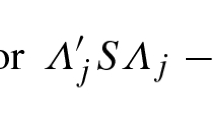Abstract
A construction method is given for all factors that satisfy the assumptions of the model for factor analysis, including partially determined factors where certain error variances are zero. Various criteria for the seriousness of indeterminacy are related. It is shown that Green's (1976) conjecture holds: For a linear factor predictor the mean squared error of prediction is constant over all possible factors. A simple and general geometric interpretation of factor indeterminacy is given on the basis of the distance between multiple factors. It is illustrated that variable elimination can have a large effect on the seriousness of factor indeterminacy. A simulation study reveals that if the mean square error of factor prediction equals .5, then two thirds of the persons are “correctly” selected by the best linear factor predictor.
Similar content being viewed by others
References
Anderson, T.W. (1984).An introduction to multivariate statistical analysis. New York, NY: Wiley.
Anderson, T.W., & Rubin, H. (1956). Statistical inference in factor analysis.Proceedings of the Third Berkeley Symposium, 5, 111–150.
Apostol, T.M. (1974).Mathematical analysis (2nd ed.). Reading, MA: Addison-Wesley.
Bargmann, R.E. (1957).A study of independence and dependence in multivariate normal analysis (Mimeo Series No. 186). Chapel Hill, NC: University of North Carolina, Institute of Statistics.
Bartholomew, D.J. (1996). Response to Dr. Maraun's first reply to discussion of his paper.Multivariate Behavioral Research, 31, 631–636.
Browne, M.W. (1968). A comparison of factor analytic techniques.Psychometrika, 33, 267–334.
Capińsky, M., & Kopp E. (1999).Measure, integral and probability. London, U.K.: Springer.
Elffers, H., Bethlehem, J., & Gill, R.D. (1978). Indeterminacy problems and the interpretation of factor analysis results.Statistica Neerlandica, 32, 181–199.
Green, B.F. (1976). On the factor score controversy.Psychometrika, 41, 263–266.
Guttman, L. (1955). The determinacy of factor score matrices with implications for five other basic problems of common-factor theory.The British Journal of Statistical Psychology, 8, 65–81.
Harris, C.W. (1967). On factors and factor scores.Psychometrika, 32, 363–379.
Heerman E.F. (1964). The geometry of factor indeterminacy.Psychometrika, 29, 371–381.
Howe, W.G. (1955).Some contributions to factor analysis (Rep. No. ORNL-1919). Oak Ridge, TN: Oak Ridge National Laboratory.
Jöreskog, K.G. (1967). Some contributions to maximum likelihood factor analysis.Psychometrika, 32, 443–482.
Kano, Y. (1986). A condition for the regression predictor to be consistent in a single common factor model.British Journal of Mathematical and Statistical Psychology, 39, 221–227.
Kestelman, H. (1952). The fundamental equation of factor analysis.The British Journal of Statistical Psychology, 5, 1–6.
Krijnen, W.P. (1996). Algorithms for unweighted least squares factor analysis.Computational Statistics and Data Analysis, 21(2), 133–147.
Krijnen, W.P. (2001).Convergence in mean square of factor predictors. Manuscript submitted for publication.
Krijnen, W.P., Dijkstra, T.K., & Gill, R.D. (1998). Conditions for factor (in)determinacy in factor analysis.Psychometrika, 63, 359–367.
Krijnen, W.P., Wansbeek, T.J., & ten Berge, J.M.F. (1996). Best linear predictors for factor scores.Communications in Statistics: Theory and Methods, 25, 3013–3025.
Lawley, D.N., & Maxwell, A.E. (1971).Factor analysis as a statistical method. Durban, South Africa: Lawrence Erlbaum.
Lee, S.Y. (1980). Estimation of covariance structure models with parameters subject to functional restraints.Psychometrika, 45, 309–324.
Luenberger, D.G. (1969).Optimization by vector space methods. New York, NY: John Wiley.
Magnus, J.R., & Neudecker, H. (1988).Matrix differential calculus with applications in statistics and economics. Chichester, U.K.: John Wiley and Sons.
Maraun, M.D. (1996). Methaphor taken as math: Indeterminacy in the factor analysis model.Multivariate behavioral Research, 31, 517–538.
McDonald, R.P. (1974). The measurement of factor indeterminacy.Psychometrika, 39, 203–222.
McDonald, R.P. (1996). Latent traits and the possibility of motion.Multivariate Behavioral Research, 31, 593–601.
McDonald, R.P., & Bolt, D.M. (1998). The determinacy of variables in structural equation models.Multivariate Behavioral Research, 33, 385–401.
McDonald, R.P., & Burr, E.J. (1967). A comparison of four methods of constructing factor scores.Psychometrika, 32, 381–401.
Meijer, E., & Wansbeek, T. (1999). Quadratic prediction of factor scores.Psychometrika, 64, 495–507.
Mulaik, S.A. (1976).Comments on “The measurement of factorial indeterminacy”.Psychometrika, 41, 249–262.
Mulaik, S.A. (1996). On Maraun's deconstructing of factor indeterminacy with constructed factors.Multivariate Behavioral Research, 31, 579–592.
Mulaik, S.A., & McDonald R.P. (1978). The effect of additional variables on factor indeterminacy in models with a single common factor.Psychometrika, 43, 177–192.
Neudecker, H., & Satorra, A. (2000).On best affine prediction. Manuscript submitted for publication.
Numerical Algorithms Group (1995).NAG foundation toolbox for use with MATLAB. Natick, MA: The MathWorks.
Penrose, R. (1955). A generalized inverse for matrices.Proceedings of the Cambridge Philosophical Society, 51, 406–413.
Rudin, W. (1976).Principles of mathematical analysis (3rd ed.). New York, NY: McGraw-Hill Inc.
Schneeweiss, H., & Mathes, H. (1995). Factor analysis and principal components.Journal of Multivariate Analysis, 55, 105–124.
Schönemann, P.H., & Wang, M-M. (1972). Some new results on factor indeterminacy.Psychometrika, 37, 61–91.
Steiger, J.H. (1979). Factor indeterminacy in the 1930's and the 1970's some interesting parallels.Psychometrika, 44, 157–167.
Steiger, J.H. (1996). Coming full circle in the history of factor indetermincy.Multivariate Behavioral Research, 31, 617–630.
ten Berge, J.M.F., & Nevels, K. (1977). A general solution to Mosier's oblique Procrustes problem.Psychometrika, 42, 593–600.
ten Berge, J.M.F., Krijnen, W.P. Wansbeek, T.J. & Shapiro, A. (1999). Some new results on correlation preserving factor scores prediction methods.Linear Algebra and its Applications, 289, 311–318.
Vittadini, G. (1989). Indeterminacy problems in the Lisrel model.Multivariate Behavioral Research, 24, 397–414.
Williams, J.S. (1978). A definition for the common-factor analysis model and the elimination of problems of factor score indeterminacy.Psychometrika, 43, 293–306.
Wilson, E.B. (1981). Review of the “Abilities of man, their nature and measurement” by C. Spearman.Science, 67, 244–248. (Reprinted fromMultidimensional data representations: When and why, pp. 375–379, by I. Borg (Ed.), 1928, Ann Arbor, MI: Mathesis.)
Author information
Authors and Affiliations
Corresponding author
Additional information
I would like to thank Willem Schaafsma for useful discussions pertaining to the model for factor analysis. I am indebted to Peter Molenaar and Conor Dolan for their comments on the manuscript. Additionally, I thank the reviewers for the constructive remarks on an earlier draft of the paper.
Rights and permissions
About this article
Cite this article
Krijnen, W.P. On the construction of all factors of the model for factor analysis. Psychometrika 67, 161–172 (2002). https://doi.org/10.1007/BF02294714
Received:
Revised:
Issue Date:
DOI: https://doi.org/10.1007/BF02294714




